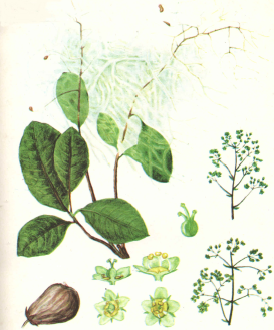A branching shrub or, less commonly, a small tree with yellow wood. The leaves are rounded or elliptical, smooth, with petioles and main veins typically red-violet. Inflorescences form at the tips of branches as large, sprawling panicles. The flowers are inconspicuous, greenish-white, with a double perianth; some are bisexual, and others are staminate on the same plant. The fruits are small drupes with a drying pericarp. The pedicels of numerous sterile flowers elongate significantly after flowering, developing long, tangled, densely hairy orange-red threads, giving the shrub a highly decorative appearance. It blooms from June to July and bears fruit from August to September.

It grows in mountainous regions, on rocky slopes, chalk outcrops, among shrubs, and in sparse forests throughout the Caucasus, Crimea, and parts of southern Ukraine. Currently, it is widely cultivated in protective forest plantations as a leading secondary canopy species.
The leaves contain 12–20% tannin and 3–5% free gallic acid and are used to extract tannin. Additionally, the leaves and wood contain flavonol glycosides such as myricetin, fisetin, and others, and are used as a yellow dye. They also contain approximately 0.1–0.2% essential oil with a pleasant fragrance, used in perfumery.
